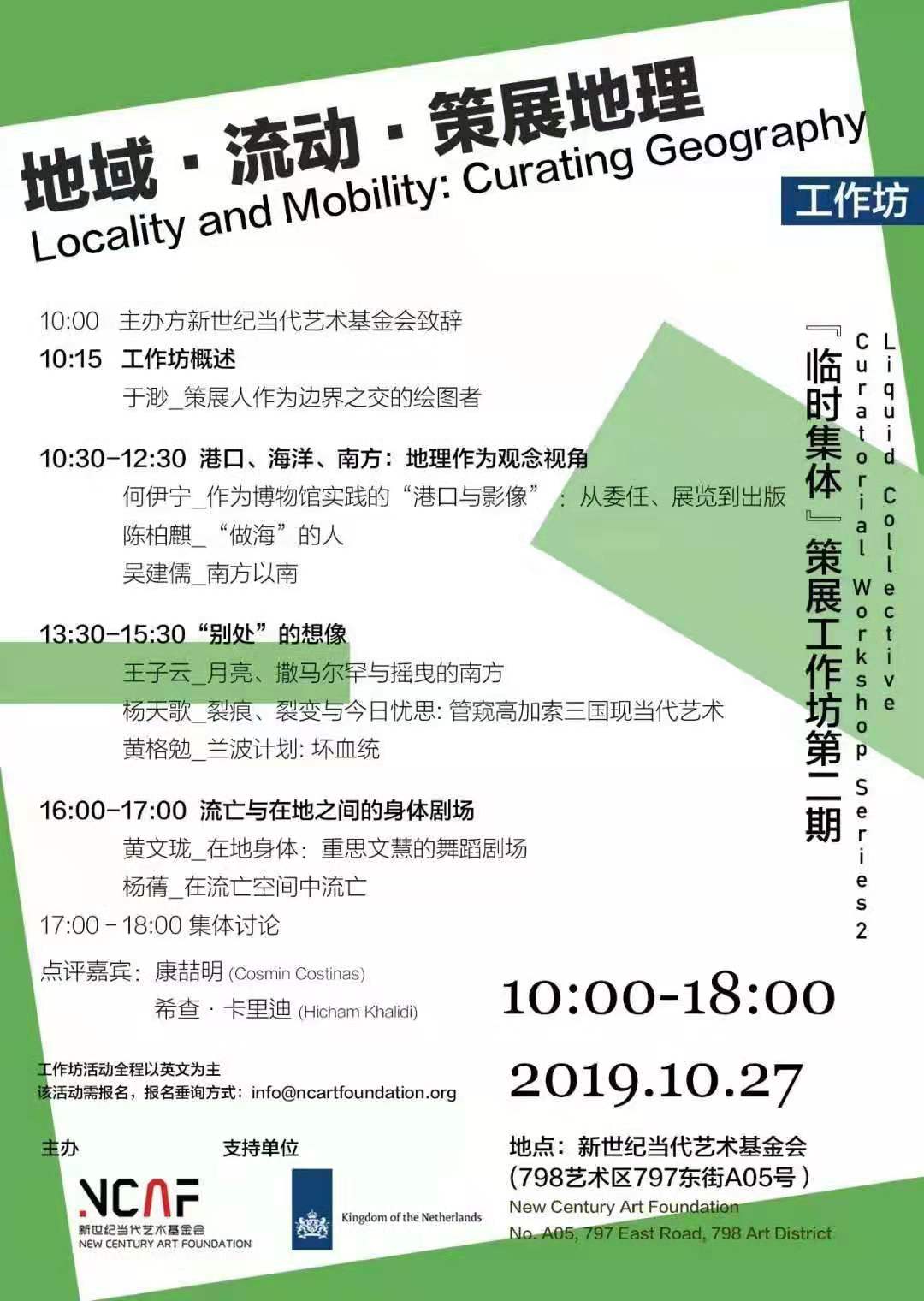
工作坊介绍:
地域·流动·策展地理
新世纪当代艺术基金会与艺术史学者、策展人于渺联合发起“地域·流动·策展地理”工作坊。工作坊将“策展地理”作为一种思想动力、实践条件和观念视角,邀请国内外策展人在全球和在地之间的多重地理关系中重新放置并观照自身工作。“地理”能否成为艺术实践和展览实践的观念和方法?积极的地理想像能否成为扭转中心与边缘关系的途径?在去中心化的跨网络链接中,我们能否实践出适应新知识生产的策展模式?在此,“策展”不仅仅局限于展览策划,更是一个跨学科的研究、展览、出版、空间实践、替代教育和知识交换的宽泛框架。
自80年代末期,哈瓦那双年展和“大地魔术师”等一系列重要展览开启了西方艺术中心与非西方边缘地带之间的角力场域,90年代接踵而来的国际双年展亦成为重新分配全球和地方地理想像的契机。侯瀚如、奥奎·恩佐尔等第一代全球流动的策展人将“中间地带”、“贸易路线”、“紧急区”等地理隐喻作为策展观念。 他们在努力扭转西方中心的艺术史视角的同时,也将艺术家的工作放置在变动的地缘关系中思考并展示。近年来,新一代的策展人更为有意识地建立传统中心以外的全球南方联盟,从“南方以南”、“一带一路”、“丝绸之路”等地理象征出发,进一步探索新的艺术关系和展览模式。近年在“新机构主义”的倡导下,全球各地兴起的中小研究型艺术机构更关乎深入社区的基础上建立机构之间的跨国网络、出版、研讨、驻地项目和游走式的替代教育。单一均质的“全球化”正被地方与地方之间的多元流动的网络所取代, “当代性”也被注入多元、叠加的、错落的在地谱系。
此工作坊邀请两位国外策展人,香港Para Site艺术空间的执行总监及策展人康喆明(Cosmin Costinas)和荷兰Jan van Eyck艺术学院院长、沙迦双年展项目策展人希查·卡迪里(Hicham Khalidi),将分别就地域、流动和策展地理带来两场讲座。同时,我们将招募八位国内策展人与康喆明和希查·卡迪里共同探讨他们正在酝酿或有待延展的策展、出版和研究项目。每位参与策展人的演讲需围绕一个具体的研究议题,可以关乎但并不限于:流动视角下的多元现代主义、作为方法和集结方式的“南方”、腹地网络、“一带一路”、港口与航线、地方化的身体与网络化的身体、本土独立艺术空间与跨地域网络等等。毋需贡献结论,重在提出问题、激发讨论。
About the Workshop
Locality and Mobility: Curating Geography
The New Century Art Foundation is pleased to announce “Locality and Mobility: Curating Geography” in collaboration with art historian and curator Mia Yu. In the context of the workshop, “curating geography” refers to intellectual motivation, practical conditions, and conceptual perspectives. Curators from China and abroad are invited to reposition and reflect on their own work in relation to the multilayered geographic relationship between global and local fields. Can “geography” become a concept and method for artistic and curatorial practices? Can active geographic imagination reverse the relationship between central and marginalized entities? Can we come up with a curatorial mode suitable for new forms of knowledge production through practices in decentralized cross-network relationships? Here, the meaning of “curating” is no longer limited to the planning of exhibitions, but refers to a broad framework that includes cross-disciplinary research, exhibition, publication, spatial practice, alternative education and knowledge exchange.
Since the late 1980s, a series of important exhibitions such as the Havana Biennial and Les Magiciens de la Terre started a wrestling match between the centers of western art and the marginalized non-western regions. International biennials that flourished in the 1990s also became an opportunity to reallocate global and local geographic imaginations. The first generation of global curators (including Hou Hanru and Okwui Enwezor) utilized geographic metaphors such as “intermediate zones”, “trade routes”, and “emergency zones” as curatorial concepts. They not only tried to reverse the Eurocentric view of art history, but also considered and showcased artists’ works in the context of changing geopolitical relationships. In recent years, a new generation of curators is consciously constructing a globalized southern league outside the traditional centers of art. Starting from geographic symbols such as “The Hidden South”, “The Belt and Road Initiative”, and “The Silk Road”, these curators have embarked on a more in-depth exploration of new artistic relationships and curatorial modes. Under the current influence of “neo-institutionalism”, smaller art research institutions around the world have become more concerned with the construction of international networks, publications, conferences, residencies and alternative (traveling) educational modes between institutions on the basis of community outreach. Uniform and homogenized understandings of “globalization” are being replaced by diverse, mobile networks between different localities, and the concept of “modernity” is being fortified by diverse, multilayered, and varying local genealogies.
NCAF has invited two international curators to join the workshop—Cosmin Costinas, the executive director and curator of Para Site (Hong Kong), and Hicham Khalidi, the director of the Jan Van Eyck Academie (Maastricht) and curator of the ACT II group exhibition in the Beirut Sharjah Biennial (2017). They will give two lectures on the subject “locality, mobility, and curating geography”. At the same time, we would also like to invite 8 local curators to join Cosmin Costinas and Hicham Khalidi in the discussion of their upcoming and ongoing curatorial endeavors, publications, and research projects. Each participant will give a speech on a specific research topic, which can be related to (but not limited to): diverse forms of modernism from a mobile perspective; “the South” as a method and a form of assembly; hinterland networks; “the Belt and Road Initiative”; ports and routes; the localized body vs. the networked body; and independent local art spaces vs. cross-regional networks. The speaker is not expected to draw any conclusions and is welcome to leave the lecture open-ended, as the purpose of the workshop is to raise questions and start conversations.
讲座摘要
作为博物馆实践的“港口与影像” :从委任、展览到出版
何伊宁
“港口与影像”是中国港口博物馆委任摄影史学者、策展人何伊宁策划、组织的研究型策展项目,初衷是通过委任艺术家展开摄影和相关媒介的实践,来探索全球经济一体化背景下中国港口地区发展的现实环境,以及港城空间关系下衍生出的不同议题。
该项目自2015年开启以来,以两年为一期,共邀请15位艺术家参与其中。2017年展览以“行动中的中国港城影像计划”为题,委任艺术家针对七座港口城市(宁波、泉州、广州、南京、上海、香港、大连)的港口、腹地、贸易空间,以及空间内所展开的人的活动进行深入的挖掘。第二期“消失的码头:在时空与记忆之间”在委任艺术家的范围、内容和呈现方式的多样化上予以拓展,项目考察的对象将从海港伸到沿江和内河港城,内容包含了针对港口和城市历史、文化;港口文化的变迁以及针对“港口”作为一个特殊的空间的视觉探索。
演讲将以“港口与影像”过往两期展览的研究、委任、展览和出版经验作为背景,试图在中国语境下探讨作为知识生产的博物馆实践是如何基于港口这一具有流动性的文化地理概念,与当代影像艺术、独立策展人和艺术家之间产生对话的;并尝试将观众的视角纳入进议题,反思在传统博物馆空间中搭建展览叙事的不同可能性。
Abstract
”The Port and the Image” as Museum Practice: Commission, Exhibition and Publication
He Yining
Commissioned by the China Port Museum, “The Port and the Image” is a research-based curatorial project designed and organized by photography historian and curator He Yining. The mission of the project is to commission artists’ projects (in photography and related media) in order to explore the realities of the development of Chinese port districts in the context of global economy and the new problems that have arisen with the current spatial relationship between ports and urban spaces.
The project was launched in 2015, and has since put out two biannual exhibitions with the participation of 15 artists in total. The inaugural exhibition in 2017, titled “The Port and the Image: Documenting China’s Harbor Cities”, commissioned artworks that explored the ports, hinterlands, commercial spaces, and human activities within such spaces in seven Chinese port cities (Ningbo, Quanzhou, Guangzhou, Nanjing, Shanghai, Hong Kong, and Dalian). The second edition of the project, “The Disappearing Harbor: Between Time, Space and Memory”, has broadened the scope and diversity of commissioned artists, contents, and methods of presentation, and has expanded the subject of investigation to include inland port cities. The contents include visual explorations of the histories and cultures of ports and cities, the evolution of port culture, and the “port” as a unique space.
Starting from the process of research, commission, exhibition, and publication of the first two “Port and the Image” exhibitions, this talk will explore the way curatorial practice as a form of knowledge production, which in this case was centered on “ports”, a mobile cultural-geographic concept, created dialogues between contemporary image art, independent curators and artists in the context of the Chinese society. It will also take the audience’ perspective into consideration and reflect on different possibilities to construct curatorial narratives in traditional museum spaces.

Reply